I just wrapped up my first full day exploring Copenhagen (remember, it’s nine hours ahead of Portland over here). From a bicycling perspective it’s simply remarkable.
They have a 36% bicycle mode share and in some parts of the central city it’s over 50%. What caught my eye at first was the sheer numbers. The packs of riders are larger than I’ve ever seen. I’m staying just a block off of Nørrebrogade (“North Bridge”) which is one of the busiest bike streets in the world. On some days they can see 38,000 bicycle trips over Queen Louise’s Bridge which feeds into it from the southeast. (Nørrebrogade deserves it’s own post. Stay tuned tomorrow.)
While Nørrebrogade is impressive, nearly every street I went down was teeming with people on bikes. And what’s even more exciting to my American eyes are who’s cycling. This is truly an “8-80” riding population. That is to say there are older people as well as young children (under age 8 in many cases) riding their bikes in city traffic. And the gender split? As you can see in my photographs, women often outnumber men.
I was mentally prepared for this. I’ve seen photos and videos of it for seven years now. But it’s still awe-inspiring.
The reason so many people ride here is due in large part because the network of cycle tracks, bike-only paths, bike lanes, and side streets will take you anywhere you want to go quickly and comfortably. There are a lot of reasons that account for Copenhagen’s high bike ridership; but the infrastructure is at the foundation.
Today I spent about 15 hours out in the city (about seven of which were spent sitting and chatting with Mikael Colville-Andersen of Copenhagenize). I mostly just wandered around and explored main streets, back streets, and everything in between. I observed the infrastructure, and more importantly, how Copenhageners use it. I’ve got lots of notes and thoughts to share; but it’s 2:20 am and I’ve got a big day planned tomorrow so I’ve got to get some rest. For now, enjoy a few of my favorite photos so far…
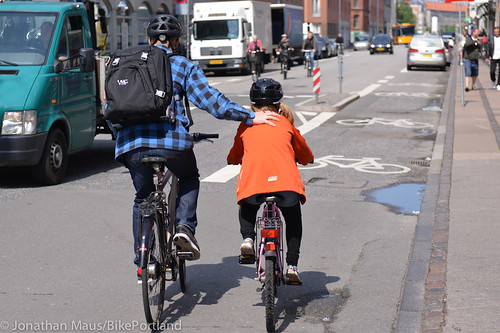
Stay tuned!

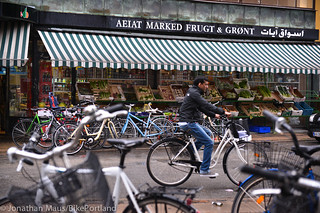
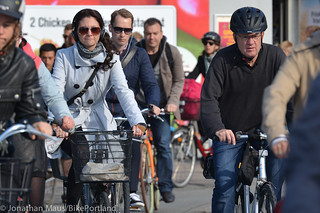
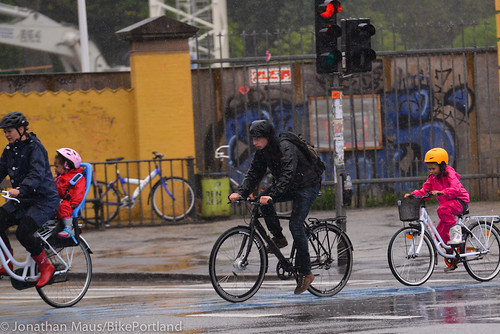

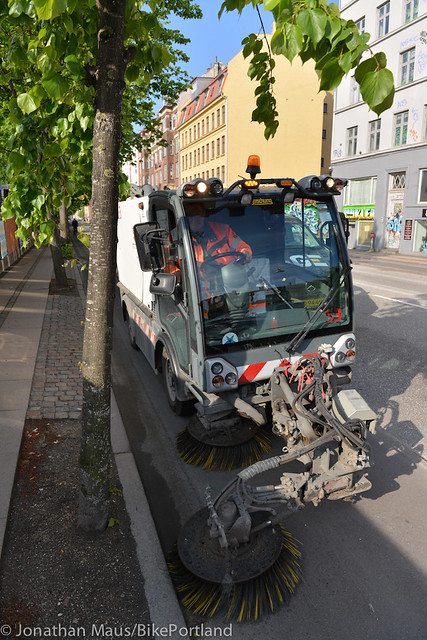
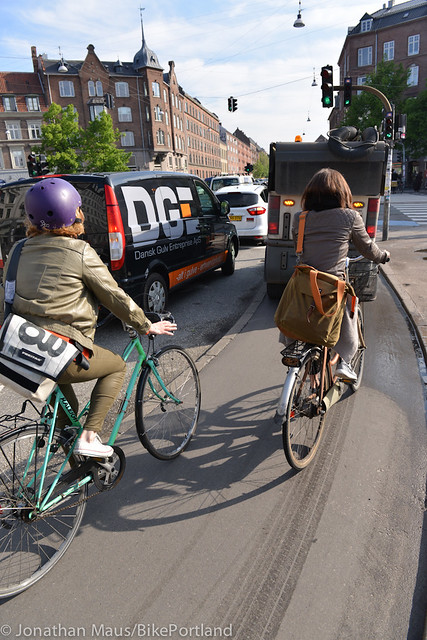
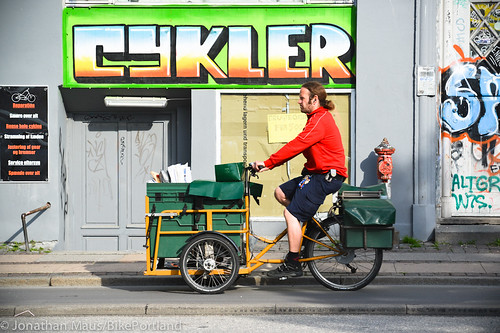

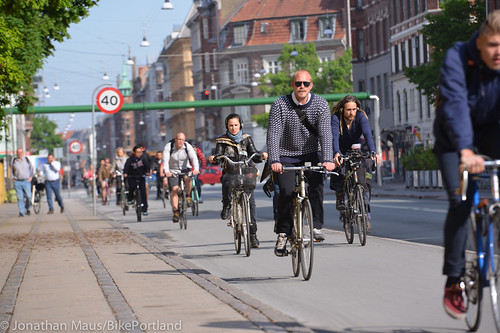

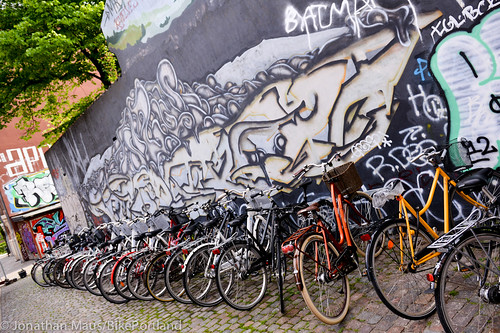
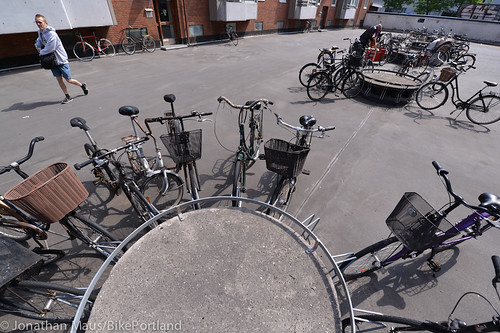
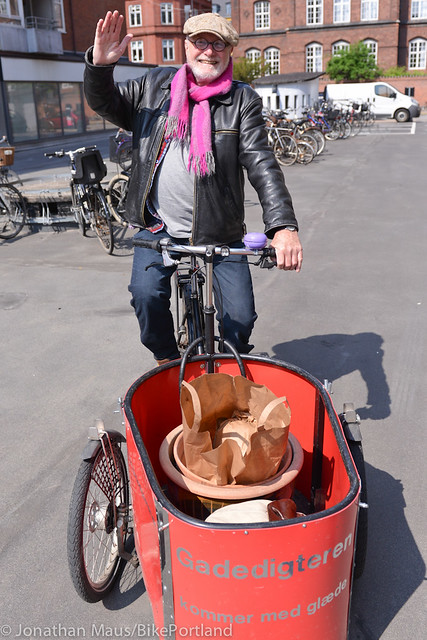
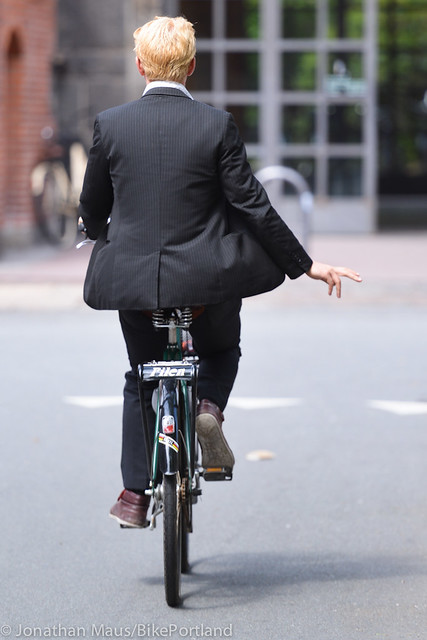
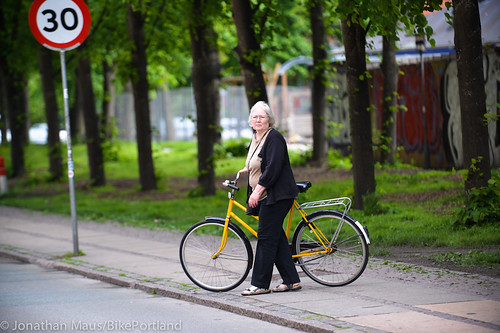
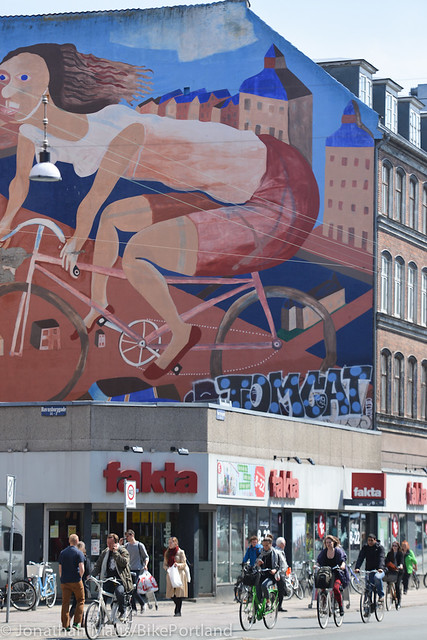
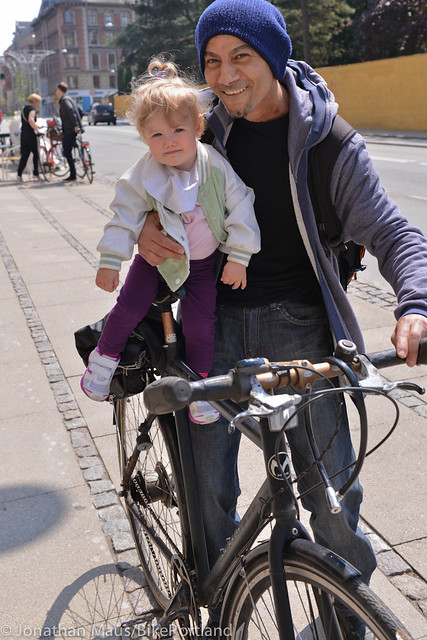
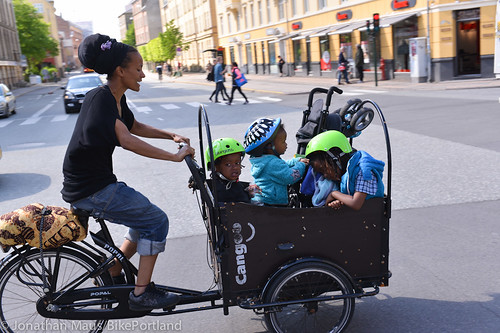
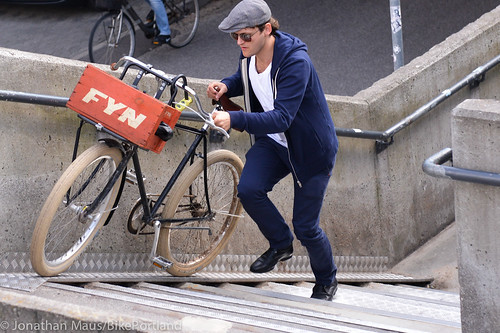
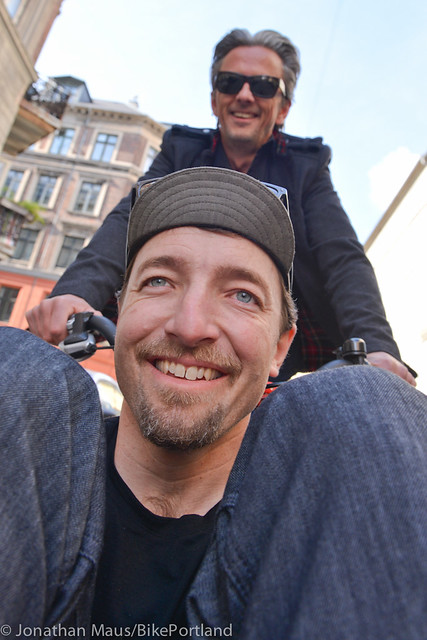
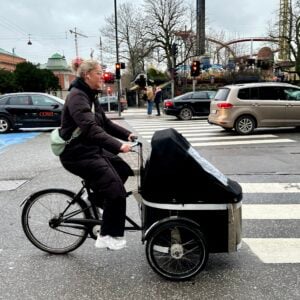
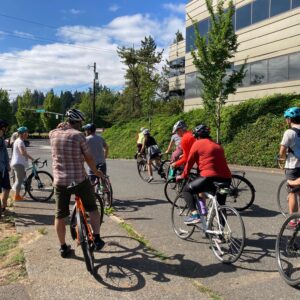


Thanks for reading.
BikePortland has served this community with independent community journalism since 2005. We rely on subscriptions from readers like you to survive. Your financial support is vital in keeping this valuable resource alive and well.
Please subscribe today to strengthen and expand our work.
I LOVE seeing so many helmetless riders!
Take cars out of the equation and you are more likely to suffer a head injury slipping in the shower than anyplace else. Funny how that works.
David Hembrow provides an interesting critique of these claims here:
http://www.aviewfromthecyclepath.com/2011/01/busiest-cycle-street-in-world.html
http://www.aviewfromthecyclepath.com/2009/12/truth-about-copenhagen.html
Some relevant quotes:
“36% of Danish adults ride a bike to work “at least once per week”. The percentage of daily commutes is not given, but it will of course be lower. ”
“The Danes now cycle for 16% of their journeys. Sadly, this is lower than the 18 or 19% measured previously and that I have quoted in the past…It’s equivalent to one in eight cyclists giving up. This is not something to celebrate – it’s terrible news.”
“For instance, Nørrebrogade is claimed to be “the busiest cycle street in the world”… Some websites go further and claim 38000 per day…However, in this case someone pointed to me that it’s unusually easy to check it for yourself…That’s 10060 cyclists per day on average by half way through 2010. It is a respectable figure, but not close to some claims which are put forward for the street.”
I was about to point these problems out, too. Jonathan, please ask city officials and boosters like MCA those kinds of critical questions. And maybe when you’re in the Netherlands you’ll have a chance to talk to Hembrow?
I think when you have a situation when there are more people cycling than cars driving around, nitpicking biking numbers is really a moot point.
That’s exactly what they are saying though, that there might not necessarily be more people cycling than cars driving around.
Citing an out of date seasonal high is misleading (especially given the apparent decline in cycling in copenhagen).
No Nørrebrogade is for real. 34 000 cyclists per day is the offical count for 2011. And it’s not a funnel. The next streets over with bridges, Fredensgade and Gyldensløvsgade, had 18 000 and 24 000 cyclists per day respectively. The lack of subjective safety is partly due to the large number of cyclists as well as the increase in cargobikes and trailers, which make the cycle paths feel congested. Copenhagen is the victim of its own success in this sense. Source Trafikken i København. Trafiktal 2007-2011.
Cycling is the number one way of getting to work and school in Copenhagen, outpacing cars as well as transit.
The problems in Copenhagen relate mostly to helmet promotion. Nationally, Denmark has a problem with fewer kids cycling to school, though I’m not sure if that applies to Copenhagen specifically.
Wow! Great pics, inspiring to see that this is real not some pipe dream
Ah, but that would never work in the US. There’s no room. And things are spread out too much.
there’s a lot of room, but it was given to cars over 50 years ago… we just need to take it back from them…
I want to think that your comment is tongue and cheek?
By definition, things being more spread out makes more room for things…
I think “spread out” means separated by long distances, rather than everything being in a relatively small vicinity. E.g., it’s not uncommon to see commute distances in the U.S. over 20 miles one way (this Washington Post article claims the average U.S. commute is 25 miles…). But those 20 or so miles are traveled along freeways, which are off-limits to bikes, and/or along streets which, due to too many auto lanes and too much on-street parking, are “too narrow” to add bike lanes or Danish-style cycle tracks.
So I think “no room” means “streets are too narrow” (which really means, “we can’t add bike space without taking away car space”), and “spread out” means “destinations are distant from each other”.
I think our region could benefit most from “bike freeways” that are paved (not jointed concrete), and off-limits to both cars and pedestrians (or provide parallel pedestrian paths). But such long-distance paths would need to be wide enough (e.g. at least 12 feet) to provide comfortable passing distance. Ideally, they would be striped with two “lanes” in each direction, a “fast lane” and a “slow lane”.
I was snarking :-). I’m tired of the status quo; it is stupid, and people say astonishingly stupid stuff in their lame attempts to justify it.
Remember that there is still a sizeable majority of commuters who live within 3 miles of work in the USofA…imagine if 50% of those commuters adopted cycling for one day a week!
Ha!
According to David Hembrow, “Too spread out” is excuse that Americans give as to why we won’t cycle or invest in our cycling infrastructure.
http://www.aviewfromthecyclepath.com/2011/02/all-those-myths-and-excuses-in-one-post.html
Gee people fudging numbers, that never happens.
Definately not in Portland where they (us) use percentages instead of actual numbers for most the “data” we accumulate. Is it any wonder that inner SE from Powell/Holgate to Irvington to eastward to about about 20th has the highest percentage of riders in the city, of course noone ever talks about how it’s mostly commercial and industrial property in that area, and thus not very populated to begin with when compaired to the land mass it encompasses.
Still because those inner Eastside stats are so great, they get vast improvements to existing infrastructure (like on Mult St.- cause of coure we all want to ride to the Lloyd Center) while most the rest of the city is stuck with painted stick riders on poorly maintained side streets.
Fact is the Netherlands still dwarfs the western world in ridership (I’m will to bet parts of China dwarf the best of the Netherlands- its just not a sexy). And thought Hembrow makes a case that the numbers don’t jive, his accounting also doesn’t take into considerations other factors. Like weather, which if it was wet or cold season easily could make for marked differences in ridership from one year to another.
While I might agree with some of your comments, I think the NE Multnomah Street improvements are quite wonderful. Prior to these improvements, I never rode Multnomah. I live in NORTH, and Vancouver to Multnomah to 20th to 24th is a great connection to Glisan, E Burnside, Stark, etc. The previous routes had me jogging all over streets in North or NE, or having to go further south to Ankeny.
Now, there is the option of Multnomah, furthermore the riding experience is very pleasant. In part because of the grade, but also because it feels much safer than riding most other busy streets.
most of the bikes have the same tail-light… why is that?
My guess is that they have a law.
I mean, why are generator hubs seemingly only produced at 3 & 6 watts? Old laws and poor legislative understanding of what lighting and electronics are actually capable of most likely.
yeah that was my guess and was going to be my comment. I’m guessing the tail and front lights are legally required and thus compliance is REALLY high.
In Germany, all bikes operated on streets are legally required to have (dynamo based) lights, a bell and reflectors in the spokes (cateyes). So every bike comes equipped with that. I’m sure that Denmark has comparable laws.
THIS. +5
What I want is a front generator hub and drum brake combo where:
() On gentle application of the brake lever the generation magnets or windings are physically moved in to the field affect area of the generator hub followed closely by the physical brake pad actuation.
The net effect would be to have a generator that had minimal drag when not intentionally slowing down (this could be tuned) but when the lever is pulled the wattage produced could easily exceed 100 Watts for a brief time; much more if you are K’Tesh or myself.
As part of the inherent safety of the mechanism the brake pads would actuate no differently than normal. The generator would simply start dragging before brake pad contact thus saving rider stamina and brake pads.
Pair up the electricity surges with some super capacitor jammed in a frame tube and we could power all the lights a bicycle needs.
I think you’re asking a lot. There’s an unpleasant combination of forces, voltages, and currents involved there. You can do a lot to cut rolling resistance just by open-circuiting the hub, but getting lots of power out is hard unless you have a way to spin the magnets past the windings very quickly.
http://money.cnn.com/pf/features/lists/global_gasprices/
Riding looks so stress free over there. I can’t handle it in Portland anymore, too many road ragers. Too many aggro cyclists, too many zombie/earbud pedestrians. I don’t think I’ve rode since November.
Oh now “pixelgate”, dont let the little things stop your love of riding!
Build up a crusty fixed gear with an old Raleigh Rampar 3spd frame, some fluffy rubber at 38-42c and fenders, a nice strong centerpull front brake, and a very moderate gear inch of say..63-65…that way you can take the crappy backstreets at a sweet and mellow pace, in total bliss!
Turn those annoying obstacles into mental targets you can slay on every ride! 🙂
Or just don’t take ladd’s or williams (better yet ride east of 39th) and you’ll have plenty of road to yourself.
“I can’t handle it in Portland anymore, too many road ragers. Too many aggro cyclists”
It seems to me that you are trying to advocate for cycle tracks by absurdly exaggerating problems with cycling in Portland.
#ourownworstenemies
That’s sad. You may want to see a psychologist. Riding a bike is only marginally more stressful than driving. I think you are making excuses.
I find biking to be very much more relaxing than driving. Every time I am forced to drive I worry it’s gonna give me a heart attack from stress. Cycling is so laid back by comparison (if you stick to the easy streets.)
Chances of dying in a bicycle accident: 1 in 4982
Chances of dying in an auto accident: 1in 108.
http://www.nsc.org/news_resources/injury_and_death_statistics/Documents/Injury_Facts_43.pdf
And, if you do not think there are aggro cyclists or cell-phone zombie pedestrians, I would challenge you to look beyond the pictures that just show how wonderful it is there.
nice excuse to stop riding 😉 Not buying it though, get out there and ride; sheer numbers will overwhelm resistance, and we have it SO much better here than most places in the US. If you think road rage is bad here try, Texas, Colorado, most of California, Florida or almost any other metro area in America. You don’t intend it but comment really borders on whining. And if you’re not riding now does that mean you’re driving? Finding road rage and manners better with that mode? Or behavior on max line? Put me on a bike any day.
It looks like most of these bikes have kickstands. Is that right? It makes sense to me to have them instead of just laying your nice bike on the ground.
Of course they have kickstands (and racks and fenders and lights and bells). Bikes are sold this way, after all they are used for transportation.
What is the situation with bike theft there? A lot? Not so much? No big deal? Hang bike thieves?
From everything I’ve read, the cycling infrastructure in nearly every city in The Netherlands (and even in many rural areas there) blows away what’s provided in Denmark. Thus, if you’re this impressed by Copenhagen, we’re all **salivating** to see what you discover in The Netherlands!! Enjoy, and thanks for all the detailed reporting! You’ve definitely earned this trip, Jonathan!! 🙂
Very true. Better off spending the entire trip in different parts of The Netherlands.
The infra in the Netherlands is crazy good. Throughout the whole country. It really is mind-blowing.
You can’t use the figures on the bike counter. It’s only counts in one direction. It counts cyclist just before they pass the counter going out off the city centre.
Denmark once again topped the OECD’s world report on life satisfaction, a.k.a. the “happiness index.” Denmark has a World Bank Gini coefficient of 24, meaning it has among the lowest level of income inequality in the world. Denmark achieved energy independence and its energy efficiency is over twice as high per capita as the U.S. Denmark has cradle-to-grave national health insurance. Denmark has under 6,000 people experiencing homelessness, more than half of them in Copenhagen — a rate under 0.1% compared to over 1% for the U.S.
Jonathan, I hope while you’re there you’ll look beyond the bike lanes at the actual conditions that affect people’s lives, keep them safe, make them happy and enables them to spend time getting around by bike. It takes more than kick-ass infrastructure to make a city like Copenhagen, something that seems to be routinely ignored by the PBOT planners who return from northern European countries so starry-eyed that they miss the important stuff. It takes real investment in human beings, not “bikes mean business” nonsense spouted by the BTA. It takes putting people first.
Denmark has very high vehicle ownership costs and fuel taxes. They have a well-developed electrically-powered national rail system, heavy and light commuter rail, and streetcars. I hate how rail transit comes under such heavy criticism on this blog. Electric rail travel and bikes are both part of the solution. When we went to Denmark we rode trains, and we rode bikes; and so did everyone else.
I hear you Michael. I’ve been thinking a lot about their tax system here and the fact that everyone has free education and universal health care. I think the priority for livable streets definitely comes in part from a sense that all Copenhageners are equal and everyone deserves a city that’s safe and affords healthy choices.
Jonathan,
very valid points. In a nutshell, there is a lot more social engineering going on there. Now, I am not saying all of that is bad, but we also have a completely different mindset in this country.
I am not sure that even the most liberal person would be willing to give up so much more in taxes for those services. Everything is a great idea when someone else is paying for it. When I have to? Well then that’s a different value equation.
…and just like the Dutch they make more bikes than motorized cars in the nation. It does bias the mind when you make a lot of something and thus you set up rules and code to allow their ease of use. As such it is the car in the US now. [Someday this mental shift might filter down to Oregon which makes more bikes that cars but the traffic laws are still focussed nationally here.]
@ spare_wheel:
Hembrow is right 36%, which has since fallen to 35% is for commutes, in and in & out of Copenhagen by residents of copenhagen and employees in copenhagen. If measured only for trips inside the city border and for trips less than 5 km, it will be significantly higher. All other danish modalshare splits, bikes will have a lower share.
Copenhagen is a great bike city compared to most capitals around the world, but the city is investing disproportionately in parking, new express ways and metro in the inner city, which all canibalizes on bicycling, in addition to force developers to build as much as 6 times as many parking spots in construction as local residents demand.
For a critical local view on bicycling and urvan development in Copenhagen, contact me or check my website (unfortunately not all blogs are in english yet), bikecopenhagen.dk or contact me directly on facebook
Its sad to hear about this regression in transportation priorities. I think that in the USA we sometimes forget that parking reduction and road diets also played a key role in the resurgence of cycling in northern europe. Thanks for the comment and I will definitely check out your web site.
Jonathan:
Be sure to check Fælledparken out thoroughly, while you are here. its the Copenhagen “Central Park” it has the greatest skater park in Northern Europe, it has a newly renovated Traffic playground for parents and kindergartens to teach bicycling and traffic for kids.
Some of the greatest playgrounds for kids in the city are here, and you will in the weekends se a wide variety of cargo bikes at alle the playgrounds. A new water playground is being installed at the moment, in addition to the soccer fields, a in-liner skating rink, two dog-playgrounds, functional fitness installations etc.
And if you get the chance, you should get somebody to take you for a trip to the 70íes and 80´ies suburbs west of copenhagen, which all has a great backbone of safe bike paths, which enable kids to bike to school and sports, mostly without having to cross in busy roads.
-And yes, modal share for bicycling is higher for women.
Thanks for the comments Lars,
Nice to hear from you. I’ll definitely check out your website. I really don’t know a ton about Copenhagen but I’m learning and it’s been very cool to be here and see it for myself! Only a few more days left and I have a lot of ground still to cover. Be in touch!
Yes Jonathan, please check out any Traffic Gardens if you get a chance!!
“The reason so many people ride here is due in large part because the network of cycle tracks, bike-only paths, bike lanes, and side streets will take you anywhere you want to go quickly and comfortably”
-Not to mention petrol is around $10 USD per gallon and it is much more expensive to own a personal auto in Europe than in the United States.
You are probably going to enjoy The Netherlands even more than Copenhagen I imagine. The Dutch cycle infrastructure is the most impressive I have utilized in all of Europe and Amsterdam has some pretty impressive bicycle traffic jams on a daily basis. Eindhoven is a smaller city, but they also have amazing cycle infrastructure that you will probably enjoy.
Keep having fun Johnathan and thanks for the pic updates!
-Cheers!
I Agree on the network effects.
However relatively to average income, its cheaper to own and drive a car in Denmark than anywhere else in Europe, and probably compared to the US as well.
To counter the relatively high taxes on petrol, there are a lot of tax deductions and schemes.
Parkoing cost is almost fully socialized, even in Copenhagen only 24% of parking is metered, and a resident parking license is less than 12 USD a month.
Insurance premiums ar probably lower too, as you don´t pay the hospital, when you disable somebody for life and so on. You cant compare the price of driving, by looking at the petrol price.
Also when you compare price of petrol, you need to look at relative to general price level and price of mass transit, which I am sure is also significantly more expensive than in Portland
Thanks for this info Lars. This was my initial thought – having never been to Copenhagen, but knowing anecdotally that gas is not subsidized in the same way (leading to much higher prices). I’d be curious to see a total cost of car ownership there done in a way that could compare to the $9k or so figure we’ve seen in OR. This would be tough to do given the differences mentioned (insurance differs greatly as the liability coverage is moot with national health care, etc.) And what % of adults own cars? Regularly drive?
As you explain it, car ownership seems like a normal thing, but used to LEAVE town, not hop around for short trips. Having a cheap resident pass means you are enticed to leave your car parked instead of driving to the few places you don’t belong and are metered.
Good stuff!
Here is a street view of the neighborhood I linked to in your previous post. If you have a chance to bike through, you’ll be in awe of the traffic calming. If only we could put picnic tables in the middle of NE Going.
http://goo.gl/maps/nVpfC
If P-town gets that street sweeper, I will operate it for $8.25 an hour.
Seriously.
$8.00 and I promise to not mention “raise” for 2 years.
Damn scab! ARGGG ! How can I compete with that? 😉
Hi
Nice account, I live in Copenhagen – in fact those round bike parking spots between the two buildings is exactly where I live (ironically there is a car park under that with more spaces than those 5 that you saw, but there is not my point). Yes Copenhagen succeeds to make non-motorized transport ATTRACTIVE. In fact one could say it has a had a informal policy of ‘car removal’. Interestingly, what is driving this policy is not so much an anti-car or a pro-bike mindset, but rather it is the reframing of the problem as one of “quality of life”. This is based a lot on the learnings from the Danish architect Jan Gehl (see his excellent book Cities for People).
Nørrebrogade is indeed an excellent example and I take pleasure in touring people there – here is my little account of it: http://bit.ly/11fjDRz . Some of the successful elements are:
– wide cycling paths on both sides
– extra wide footpath
– street furniture, including benches, plant racks and bicycle parkings
– protected bus stops and waiting islands for bus passengers, away from both car and bicycle traffic
– redesigned street lighting focusing on footpath and not the road
– continuous footpaths even on street entrances, showing to car drivers it is them crossing the footpath, and not pedestrians crossing the road
– newly added ‘handle bars’ at red lights so one does not need to put their feet on the ground when waiting (now that is sweet)
– newly painted ‘taking over’ lanes for those who bike faster (as on Dronning Louise’s bridge, where the bike lane is three bicycles wide on each side)
– and tilted garbage cans, so it is easier to throw that empty coffee cup at high bicycle speed!
My experience is that you are right: all this infrastructure makes it safe, comfortable, and fast to use the bike for everyone – even me with a kid. It is that simple. No more road rage in trying to share the space, bicyclists are heard and understood.
Anyway if you are in Copenhagen for a while, you are welcome to contact me. I study/work at the Danish Technical University, Transport department, Sustainability team 🙂
cheers
Yannick
I concur with Yannick’s recommendation on reading Jan Gehl. And I would add his earlier book too: Life Between the Buildings.
“newly painted ‘taking over’ lanes for those who bike faster (as on Dronning Louise’s bridge,”
http://goo.gl/maps/1Lgt6
Very cool!
Jonathan, do they have the car vs. bike polemic going on there? I’d be interested to hear your observations on that.
YES, its a constant battle, and actually we get a lot of media coverage of the “dangerous cyclists” though there are years between serious accidents.
Cars are still associated with the sixties image of econoomic growth and business friendliness and so on, but really, the city does not provide for goods distribution and so on, its all about privately owned cars, mostly used in peoples sparetime, not business, not about the needed car traffic, such as distribution, garbage trucks construction vans and so on.
My observation about European cyclist is that everyone has an “upright” riding position. Maybe that has something to do with the safety factor in regards to not needed a helmet.
That is what I saw in Munich too., People commuting for transportation at a mellow pace, with speeds similar. Riders are not using urban commuter routes for training
Probably any number of factors here… Two closely related factors being density and travel distance. For commutes of less than 2 miles in dense urban areas there is much less benefit to trying to hurry. Relax and enjoy the ride and get there in less than 10 minutes anyway. Regarding those two factors alone most USA cities will take a long time to catch up. When commuting 5 miles and even more so 10 miles, speed becomes a significant factor.
For example, I commonly ride a 12 mile route between Vancouver and Hollywood. I have ridden that on an upright 3 speed many times, pushing the pace at times because of the distance, but the bike isn’t at all encouraging for faster riding. On the 3 speed it takes me nearly 90 minutes. On a road bike set up for commuting with fenders and racks I ride it in just under 50 minutes. On a sport cycling road bike I have done it in less than 40 minutes. The fairly insignificant 5 minutes or less difference of a two mile trip (less when locking and clothing are considered) becomes a big deal for a longer commute.
So, on the main corridors that run a great distance from the outer areas of PDX and beyond we are going to see speed oriented commuters for a long time. IF density increased in the inner areas and cycling is nourished, we will probably see more European style bikes and riding in central PDX. At the same time, PDX should still accomodate the longer commuters, especially since we don’t have good transit options on a lot of these routes.
Too many cyclists / too dense for Cat VI style riding…a grim and disheartening look at our future 😉
Heh, it truly is disheartening if my 13-mile commute takes two hours instead of one. That would cinch it for me–back in the car; transit passes are too expensive, and transit as good as unavailable where I live.
Copenhagen and the suburbs, 20+ of them, work together to make commuter routes in and out of Copenhagen, where you can ride fast on the long stretch. The quality and aspirations are not all I would hope for, but still there is some effort.
13 miles is to long for most people to bike back and forth, people tend to fall off at distances between home and work more than 6 miles.
But there is a great alternative, the five-finger metro-train system, which is 5 radial line 12-18 miles out of copenhagen, you can bring your bike for free, so there is a great possibility to combine mass transit and bike, and beat the speed of cars, at less cost, and no need for parking in the city!
Still, if we want to increase bike modal share, we need really high grade bike paths, which stops for nothing.
We need to get people to go longer distances, which means we must improve the average uninterrupted stretches, more underpasses and intersections prioritized for bikes, better separation of busstops and bikelanes.
The most desirable solution is to make a network along the fivefinger metro-system, bikepaths following the train over and under crossing streets, wide enough to accomodate cabin-bikes which will make you go 50 km/h without any electricity assist.
I guess you have not seen the video of Jimmie “Jumbo” Bargiesen in CPH:
http://www.youtube.com/watch?v=6aahtm3PXQs
For the sake of all children, please watch this film at work or after you tuck in the little ones tonight. Let’s not sully the minds of future commuters with the scofflaw antics of Jimmie Jumbo.
The picture of the elderly woman reminds me of my 72-year old mom in Germany. She is doing most of her errands by bike in her small town. It’s a normal form of transportation for her. However, she would never get on a bike while visiting us here in SW Portland. Traffic is too scary and fast, bikes are too fast (she is used to coaster brakes for example). She would also stop bicycling (in Germany) if she had to wear a helmet.
Regarding the higher percentage of woman biking: of course more woman bike in Denmark (and other northern European countries). Biking is not a testosterone driven speed race nor a war zone like it often feels here in Portland. Biking is safe and at a slower pace. People also wear their normal clothes (and shoes) and no helmets. That means no worry about your safety, clothes or helmet hair. Add to that that women don’t need the status symbol of cars as much as men and you get a higher gender share.
Cool and interesting pictures.
There must be a city law against drop bars? Just kidding.
Lot of diversity in those photos. Looks just like Portland.
Shame on them for being born white.
A whole different world. I can’t believe it’s on the same planet.
Also, did you notice the speed limit signs? 40 and 30 kmh (25 and 20 mph)? Even the regular upper speed limit that is in place in all European cities, 50 kmh (30 mph), would be dream here. You don’t find the highway speeds we regularly have here on streets like Barbur, Beaverton-Hillsdale or Powell on European city streets unless they are completely separate from housing, pedestrians and bicyclists like a freeway. Speed limits also don’t change every few yards like they do here (so ubiquitiously that people just tune them out). 50 kmh is not even posted as it is the general speed limit in cities. Only if the speed is lower, like 20 mph or even “walking speed” in residential areas, you’ll see speed limit signs. And then people pay attention (and speed cameras help reminding them).
Great pics and exciting that you are there, Jonathan.
My eye was drawn to the background of many images where 5-story development with little-to-no parking appears to be the norm. I hope while you are there you have the opportunity to explore how bicycling fits in with other elements of transportation and land use: density, mixture of uses, parking, affordable housing, transit network design, car taxes.
Looking forward to more pictures and reporting!
I agree with the comment on bike and rail transportation. They do fit very well together. Be sure to check out all the trams (streetcars) in Amsterdam. Combining bike with MAX or Streetcar is pretty normal for me and very easy.